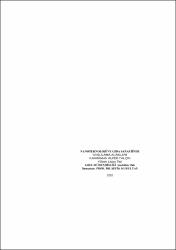| dc.contributor.author | Yalçın, Kahraman Alper | |
| dc.date.accessioned | 2017-05-03T13:10:09Z | |
| dc.date.available | 2017-05-03T13:10:09Z | |
| dc.date.issued | 2010 | |
| dc.identifier.uri | https://hdl.handle.net/20.500.11776/657 | |
| dc.description.abstract | Nanoteknoloji, maddeler üzerinde nanometre ölçeğindeki boyutlarda gerçekleştirilen tasarım, üretim, uygulama, düzenleme ve kontrol gibi çalışmalar anlamına gelmektedir. Nanoteknoloji genel olarak 10–100 nm veya daha küçük boyutlardaki maddelerle ilgilenmektedir. Gıdalardaki proteinler, 10–100 nm boyutları ve globüler yapıları ile gerçek nano-partiküller olarak nanoteknolojik çalışmalara konu olmaktadırlar. Birçok polisakkarit ve katı yağlar bir nm’ den küçük boyutları ile nano yapıda lineer polimerlere örnek gösterilebilir. Jelleşme özelliğindeki gıdalarda katı partiküllerin dispersiyon fazı içinde homojen dağılması, emülsiyonlarda 2 ve 3 boyutlu moleküler ağ yapısından yağ ve su fazlarının ayrılması, nişasta çözeltisinin kaynatılarak eritilmesi ve jelleşmesi sırasında oluşan üç boyutlu kristal yapılarındaki değişim aslında hep nano boyutta gerçeklesen olaylardır. Çalışmada, nano teknoloji bilimi, birçok gıda isleme ya da pişirme yönteminin gıda içindeki nano yapıda doğal bir modifikasyona ya da yeni nano yapıların oluşumuna yol açtığı, nano bilim sayesinde bu işlemlerin çok daha iyi anlaşılabileceği ve mevcut isleme yöntemlerinin geliştirilebileceği, nanoteknolojinin daha iyi bir hammadde seçimi ve gıda ambalaj maddeleri üretiminde kullanımı ile nanoteknoloji sayesinde geliştirilen likopen gibi sentetik partiküllerin oluşumu ele alınmıştır. | en_US |
| dc.description.abstract | Nanotechnology means studies such as design, production, application, regulation and control realized on materials in nanosized scales. Nanotechnology is generally concerned with materials of 10-100 nm or smaller sizes. Proteins in foods have been subject to nanotechnology studies as real nanoparticles with their size of 10-100 nm and with their globular structures. Many polysaccharides and solid oils can set examples nanostructured linear polymers with their size smaller than 1 nm. Homogenous diffusion of solid particles of foods that have gelation properties, separation of fat and water residues from 2 or 3 dimensional network structures in emulsions, change in three dimensional crystal structures during melting and gelation of starch by boiling are all issues happening in nanosize. In the study, nanotechnology science that helps formation of novel nanostructures or a natural modification of food processing or cooking methods in foods, a better understanding of nanotechnology and current processing methods due to this technology, better raw material selection for nanotechnology and their use in food packaging and formation of synthetic particles such as lycopene that are developed by nanotechnology were considered. | en_US |
| dc.language.iso | tur | en_US |
| dc.publisher | Namık Kemal Üniversitesi | en_US |
| dc.rights | info:eu-repo/semantics/openAccess | en_US |
| dc.subject | Nanoteknoloji | en_US |
| dc.subject | Gıda Ambalajlama | en_US |
| dc.subject | Nanotechnology | en_US |
| dc.subject | Food Packaging | en_US |
| dc.title | Nanoteknoloji ve gıda sanayiinde uygulama alanları | en_US |
| dc.title.alternative | Nanotechnology and its application areas in food industry | en_US |
| dc.type | masterThesis | en_US |
| dc.department | Enstitüler, Fen Bilimleri Enstitüsü, Gıda Mühendisliği Ana Bilim Dalı | en_US |
| dc.relation.publicationcategory | Tez | en_US |



















